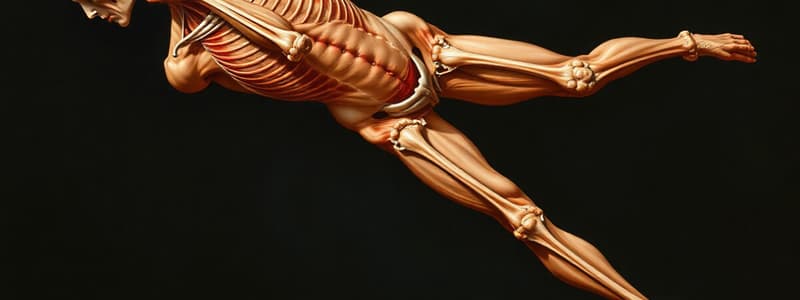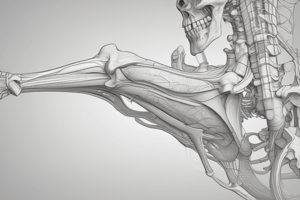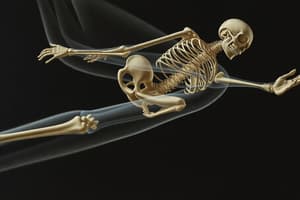Podcast
Questions and Answers
In the context of a convex joint surface moving on a fixed concave surface, what direction does the glide occur relative to the roll?
In the context of a convex joint surface moving on a fixed concave surface, what direction does the glide occur relative to the roll?
- Perpendicular to the roll
- Variable depending on joint type
- In the same direction as the roll
- In the opposite direction to the roll (correct)
During open chain glenohumeral abduction, in which direction does the humeral head roll and glide respectively?
During open chain glenohumeral abduction, in which direction does the humeral head roll and glide respectively?
- Lateral roll and medial glide
- Inferior roll and superior glide
- Medial roll and lateral glide
- Superior roll and inferior glide (correct)
What is true regarding the roll direction for a given osteokinematic motion?
What is true regarding the roll direction for a given osteokinematic motion?
- It varies based on joint position
- It is consistent regardless of whether it is open or closed chain (correct)
- It depends on the type of joint surface involved
- It is always in the opposite direction of the glide
What occurs when a concave joint surface moves on a fixed convex surface?
What occurs when a concave joint surface moves on a fixed convex surface?
In the anatomical position, what is the typical movement of the humerus during shoulder abduction?
In the anatomical position, what is the typical movement of the humerus during shoulder abduction?
What defines component movements in arthrokinematics?
What defines component movements in arthrokinematics?
What is the primary function of joint play in joint mechanics?
What is the primary function of joint play in joint mechanics?
Which force causes joint surfaces to move toward each other?
Which force causes joint surfaces to move toward each other?
When joint play is restricted, what is the typical outcome on osteokinematic motion?
When joint play is restricted, what is the typical outcome on osteokinematic motion?
Which of the following is NOT a type of force involved in arthrokinematics?
Which of the following is NOT a type of force involved in arthrokinematics?
In open chain shoulder flexion, what is the direction of the glide compared to the roll of the distal humerus?
In open chain shoulder flexion, what is the direction of the glide compared to the roll of the distal humerus?
When analyzing closed chain shoulder flexion, which rule applies regarding the direction of the scapula relative to the humerus?
When analyzing closed chain shoulder flexion, which rule applies regarding the direction of the scapula relative to the humerus?
What is the glide direction during open chain external rotation of the shoulder when the distal humerus rolls posteriorly?
What is the glide direction during open chain external rotation of the shoulder when the distal humerus rolls posteriorly?
In the context of CKC pronation at the talocrural joint, if the tibia rolls anteriorly, what is the glide direction?
In the context of CKC pronation at the talocrural joint, if the tibia rolls anteriorly, what is the glide direction?
Which injury risk is posed to the glenohumeral joint due to excessive overhead throwing in end-range external rotation?
Which injury risk is posed to the glenohumeral joint due to excessive overhead throwing in end-range external rotation?
What is the correct definition of the term 'insertion' in relation to muscle anatomy?
What is the correct definition of the term 'insertion' in relation to muscle anatomy?
Which of the following best describes 'active insufficiency' in muscle function?
Which of the following best describes 'active insufficiency' in muscle function?
In the context of muscle contractions, which of the following describes an 'ISOK' contraction?
In the context of muscle contractions, which of the following describes an 'ISOK' contraction?
Which of the following characteristics best distinguishes open kinetic chain activities from closed kinetic chain activities?
Which of the following characteristics best distinguishes open kinetic chain activities from closed kinetic chain activities?
What is the significance of the 'angle of pull' in understanding muscle action?
What is the significance of the 'angle of pull' in understanding muscle action?
Flashcards
Convex on Concave Rule
Convex on Concave Rule
When a convex joint surface moves on a fixed concave surface, the rolling motion occurs in the same direction as the moving bone. The gliding motion, however, happens in the opposite direction.
Roll
Roll
The movement of a bone around its joint axis, like a wheel rolling on the ground. It is always in the same direction as the overall motion of the bone.
Glide
Glide
The movement of a joint surface across another joint surface, like a hockey puck sliding across the ice. It can happen in the same or opposite direction as the overall motion of the bone.
Open Chain
Open Chain
Signup and view all the flashcards
Closed Chain
Closed Chain
Signup and view all the flashcards
Open Chain Shoulder Flexion Glide
Open Chain Shoulder Flexion Glide
Signup and view all the flashcards
Closed Chain Shoulder Flexion Glide
Closed Chain Shoulder Flexion Glide
Signup and view all the flashcards
Open Chain Shoulder External Rotation Glide
Open Chain Shoulder External Rotation Glide
Signup and view all the flashcards
Component Movements
Component Movements
Signup and view all the flashcards
Joint Play
Joint Play
Signup and view all the flashcards
Traction Force
Traction Force
Signup and view all the flashcards
Shear Force
Shear Force
Signup and view all the flashcards
Approximation Force
Approximation Force
Signup and view all the flashcards
Muscle Origin
Muscle Origin
Signup and view all the flashcards
Muscle Insertion
Muscle Insertion
Signup and view all the flashcards
Muscle Action
Muscle Action
Signup and view all the flashcards
Concentric Contraction
Concentric Contraction
Signup and view all the flashcards
Eccentric Contraction
Eccentric Contraction
Signup and view all the flashcards
Study Notes
Kinesiology Week 2
- Covered arthrokinematics and the muscular system
- Objectives included defining open (OKC) and closed chain (CKC) movements, reviewing advantages and disadvantages of each, defining arthrokinematic motion and types, and discussions about how joint surface shapes influence motion. Also included accessory motion, joint congruency, and open and close pack positions of joints.
- Defined kinetic chains as series of rigid links connected to allow motion with a movement of one link causing motion in others in a predictable manner.
- Differentiated between closed and open kinetic chains. Closed involves a fixed distal segment and moving proximal segment. Open involves a moving distal segment and a fixed proximal segment.
- Explained the difference between osteokinematics (bone movement) and arthrokinematics (joint surface movement); arthrokinematic motion must accompany osteokinematic motion for normal joint movement. Arthrokinematics is not under voluntary control.
- Identified three types of arthrokinematic motion: roll, glide, and spin
- Expressed the convex-concave rule in relation to joint surface shape; a concave surface will roll and glide in the same direction as the distal end of the moving bone on the convex surface.
- Presented applications and review questions about open and closed chain motions as they relate to body movements, such as shoulder flexion, shoulder external rotation, and pronation. These motions were analyzed in different positions and types of movement.
- Reviewed accessory motion, including terminology defining component movements, joint play, and main forces (traction, shear, and approximation), as well as clinical relevance and examples of these forces.
- Covered the characteristics of muscle tissue (irritability, contractility, extensibility, elasticity, passive and active tension), tone (hypertonia, normotonia, hypotonia, atonia), muscle excursion, and length-tension relationships in muscle tissue.
- Described how muscles act as agonists, antagonists, stabilizers, and synergists and how the angle of pull, muscle size, and relative location to a joint axis are factors in determining roles of muscle groups and movements during activities.
- Provided examples, such as shoulder flexion, shoulder external rotation, and pronation, across different planes, body movements, and joint positions to illustrate the concepts.
- Presented learning objective statements as part of the study notes.
- Reviewed muscle attachments (origin and insertion), their roles in movement, and reversals of muscle action.
- Identified different types of muscle fibers (parallel and oblique – unipennate, bipennate, and multipennate) and their related functions.
- Defined different types of muscle contractions (isotonic and isometric) and isokinetic contractions
- Defined "across gravity" positions and how they are used in physical therapy
- Summarized the concepts of single vs. multi-joint muscles, range of motion and stretching and length-tension relationships in muscle tissue.
Studying That Suits You
Use AI to generate personalized quizzes and flashcards to suit your learning preferences.




